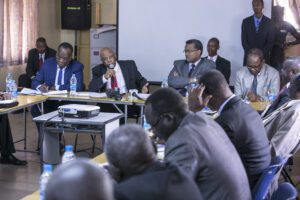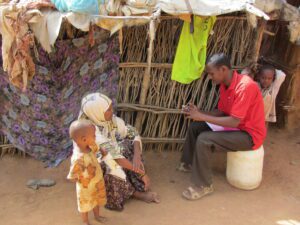In an era where public trust, accountability, and the efficient use of resources are paramount, the spotlight intensifies on how governments deliver on their promises. For Uganda, a nation striving for sustainable development and improved citizen well-being, the effective implementation and assessment of its public initiatives are critical. Central to this pursuit is a robust system of Monitoring and Evaluation (M&E). Strong M&E for government programs in Uganda is not merely a bureaucratic exercise; it is the bedrock of evidence-based decision-making, a catalyst for continuous improvement, and a vital tool for ensuring that public investments translate into tangible results for all Ugandans.
This blog post delves into the multifaceted world of M&E for government programs in Uganda, exploring its critical role, the mechanisms of its integration, the hurdles faced, and the pathways to strengthening its impact. Understanding the nuances of M&E for government programs in Uganda is essential for policymakers, civil society, development partners, and citizens alike, as it underpins the nation’s journey towards achieving its development aspirations.
The Foundational Role of M&E in Uganda’s Governance
1. What is the role of Monitoring and Evaluation (M&E) in assessing the effectiveness of government programs and policies in Uganda?
Monitoring and Evaluation (M&E) serves as the principal mechanism for systematically tracking the progress and assessing the outcomes, impact, and overall effectiveness of government programs and policies in Uganda. Its role is multifaceted:
- Assessing Performance: M&E provides objective evidence on whether programs are being implemented as planned (monitoring) and whether they are achieving their intended objectives and desired changes (evaluation). This is crucial for “evaluating public policies Uganda” against their stated goals.
- Ensuring Accountability and Transparency: Robust M&E for government programs in Uganda holds government agencies accountable to the public and funding partners by demonstrating how resources are used and what results are achieved. It fosters transparency by making program performance information accessible.
- Informing Resource Allocation: By identifying what works, what doesn’t, and why, M&E findings help policymakers make informed decisions about resource allocation, potentially shifting funds towards more effective interventions and away from underperforming ones.
- Facilitating Learning and Adaptation: M&E is a powerful learning tool. It helps identify lessons learned, best practices, and areas for improvement, enabling adaptive management where programs can be adjusted mid-course to enhance their effectiveness.
- Enhancing Stakeholder Engagement: The M&E process often involves various stakeholders, including beneficiaries, implementing partners, and civil society, thereby promoting participation and ownership.
Ultimately, effective M&E for government programs in Uganda contributes to improved service delivery, better developmental outcomes, and greater public value.
2. In what ways does M&E contribute to better decision-making and policy formulation in Uganda’s government?
M&E is instrumental in enhancing the quality of decision-making and the relevance of policy formulation in Uganda’s government. It moves governance from being based on assumptions or anecdotal evidence to being driven by data and empirical findings.
- Evidence-Based Decision-Making: M&E provides credible data on program performance, challenges, and successes. This evidence allows decision-makers to make strategic choices regarding program continuation, modification, scaling up, or termination. For instance, “performance measurement public sector Uganda” through M&E can show if a health program is reducing child mortality as intended.
- Improved Policy Design: Lessons learned from evaluating existing policies and programs feed directly into the design of new ones. If an evaluation reveals that a particular approach in an agricultural program was ineffective in reaching smallholder farmers, future policies can be designed to address these shortcomings. This iterative process strengthens “evaluating public policies Uganda.”
- Strategic Planning: M&E findings inform strategic planning processes, including the formulation of National Development Plans (NDPs) and sector-specific strategies. It helps in setting realistic targets, identifying strategic priorities, and designing interventions that are more likely to succeed.
- Identifying Unintended Consequences: Evaluations can uncover unintended positive or negative consequences of programs, providing a more holistic understanding of a policy’s impact and allowing for corrective measures.
- Advocacy and Public Debate: Credible M&E reports can stimulate informed public debate and advocacy by providing objective information about government performance, empowering citizens and civil society to demand better services and accountability. Effective M&E for government programs in Uganda can thus strengthen democratic processes.
Integrating M&E into the Public Sector Machinery
3. How do government agencies in Uganda integrate M&E into their program management cycles?
Government agencies in Uganda are increasingly working to integrate M&E throughout their program management cycles, moving away from M&E as an afterthought to an intrinsic part of program design and implementation. This integration typically involves:
- M&E in Program Design: Incorporating M&E considerations from the outset, including developing a clear results framework, defining measurable indicators, setting baselines, and establishing targets. The program’s theory of change should articulate how activities are expected to lead to outputs, outcomes, and impact.
- Dedicated M&E Plans: Developing specific M&E plans for programs, outlining the M&E questions, methodologies, data collection strategies, analysis plans, reporting mechanisms, and allocated responsibilities and resources.
- Routine Monitoring Systems: Establishing systems for regular data collection on key performance indicators throughout the program implementation phase. This allows for ongoing tracking of progress, identification of bottlenecks, and timely corrective actions.
- Periodic Evaluations: Conducting mid-term and end-of-program evaluations to assess relevance, efficiency, effectiveness, impact, and sustainability. These evaluations often involve a mix of internal and external evaluators.
- Management Information Systems (MIS): Utilizing Management Information Systems, sometimes web-based, to capture, store, analyze, and report M&E data, facilitating easier access and use of information.
- Feedback Loops: Creating mechanisms for M&E findings to be regularly reviewed by program managers and policymakers, ensuring that lessons learned are fed back into the decision-making process.
- National M&E Frameworks: The Office of the Prime Minister (OPM) and the National Planning Authority (NPA) play a significant role in guiding and coordinating M&E for government programs in Uganda through national policies like the National M&E Policy.
4. How can M&E be effectively planned and budgeted for in government initiatives?
Effective planning and budgeting are critical for the success of M&E for government programs in Uganda. Without adequate resources, M&E activities cannot be implemented thoroughly.
- Early Integration: M&E planning should begin during the program design phase, not as an add-on. This ensures that M&E activities are relevant and feasible.
- Costing M&E Activities: All M&E activities, including baseline studies, data collection tools development, staff training, data collection (personnel, travel, equipment), data analysis, evaluations, and dissemination of findings, need to be systematically costed.
- Dedicated Budget Line: Ideally, M&E should have a dedicated budget line within the overall program budget. A common rule of thumb suggests allocating between 3% and 10% of the total program budget to M&E, depending on the complexity and data needs.
- Realistic Budgeting: Budgets should be realistic, taking into account local conditions, inflation, and the scope of M&E required. Under-budgeting compromises the quality and utility of M&E.
- Resource Mobilization: If internal resources are insufficient, explore options for mobilizing additional resources, potentially from development partners who often prioritize M&E.
- Capacity Building in Budgeting for M&E: Training program managers and finance officers on how to effectively budget for M&E is crucial.
- Advocacy for M&E Funding: Champions within the government and civil society need to continuously advocate for adequate and sustained funding for M&E for government programs in Uganda.
Navigating Challenges in M&E Implementation
5. What are the main challenges faced in implementing M&E systems within Uganda’s public sector?
Despite progress, the implementation of M&E for government programs in Uganda faces several challenges:
- Limited M&E Capacity: Insufficient numbers of trained M&E professionals, particularly at sub-national levels, and inadequate M&E skills among program staff.
- Inadequate Funding: M&E activities are often underfunded, leading to compromises in scope, methodology, and frequency. Sometimes M&E budgets are the first to be cut when programs face financial constraints.
- Weak M&E Culture: A lack of demand for and utilization of M&E findings by policymakers and program managers. M&E may be viewed as a fault-finding exercise rather than a learning opportunity. This hinders effective “performance measurement public sector Uganda.”
- Data Quality and Availability Issues: Challenges in collecting reliable and timely data, weak administrative data systems, and sometimes a lack of baseline data against which to measure progress.
- Poor Coordination: Limited coordination among different government agencies involved in M&E, and sometimes duplication of efforts or conflicting M&E requirements from different stakeholders (e.g., government vs. donors).
- Political Influence: Political interference can sometimes compromise the objectivity of M&E processes and the dissemination of unfavorable findings.
- Inadequate M&E Infrastructure: Lack of appropriate tools, technologies, and systems for efficient data collection, analysis, and reporting.
- High Staff Turnover: Frequent transfers or departures of staff trained in M&E can erode institutional capacity.
Addressing these challenges is critical for strengthening M&E for government programs in Uganda.
Measuring Success: Indicators and Methodologies
6. What are the key indicators used by the Ugandan government to measure the success of its programs?
The Ugandan government uses a range of indicators to measure the success of its programs, often aligned with national development frameworks like the National Development Plan (NDP). These indicators span various levels of the results chain:
- Input Indicators: Track resources allocated to a program (e.g., budget allocated, staff trained).
- Output Indicators: Measure the direct products or services delivered by a program (e.g., number of schools built, number of farmers receiving extension services, number of children vaccinated).
- Outcome Indicators: Assess the short-term to medium-term effects of program outputs on beneficiaries (e.g., improved literacy rates, increased crop yields, reduced incidence of a specific disease). These are crucial for “evaluating public policies Uganda.”
- Impact Indicators: Measure the long-term, broader societal changes attributable to a program (e.g., reduction in poverty levels, improved national health status, enhanced economic growth).
- Process Indicators: Track the efficiency and quality of program implementation (e.g., timeliness of service delivery, adherence to guidelines).
- Sector-Specific Indicators: Each sector (health, education, agriculture, infrastructure, etc.) will have its own set of technical indicators relevant to its mandate. For example, the health sector might track maternal mortality rates, while education tracks net enrollment ratios.
- Cross-Cutting Indicators: Indicators related to gender equality, environmental sustainability, governance, and human rights are also increasingly integrated.
The National Monitoring and Evaluation System (NMES), coordinated by the OPM, provides guidance on these indicators.
7. What methods are employed for data collection and analysis in M&E for government programs in Uganda?
A variety of quantitative and qualitative methods are employed for data collection and analysis in M&E for government programs in Uganda:
- Data Collection Methods:
- Surveys: Household surveys, facility surveys, and beneficiary surveys to collect quantitative and qualitative data.
- Administrative Data: Utilizing data routinely collected by government ministries, departments, and agencies (e.g., school enrollment records, hospital patient data).
- Document Reviews: Reviewing program reports, financial records, policy documents, and other relevant literature.
- Key Informant Interviews (KIIs): Interviews with knowledgeable individuals, including policymakers, program staff, community leaders, and experts.
- Focus Group Discussions (FGDs): Group discussions with beneficiaries or other stakeholders to gather qualitative insights and perceptions.
- Direct Observation: Site visits to observe program activities and outputs directly.
- Participatory Methods: Engaging communities in data collection and analysis, such as community scorecards or participatory rural appraisals.
- Case Studies: In-depth investigations of specific projects, individuals, or groups to provide rich, contextualized information.
- ICT-based Data Collection: Using mobile phones, tablets, and web-based platforms for real-time data collection.
- Data Analysis Methods:
- Quantitative Analysis: Statistical analysis of numerical data, including descriptive statistics (means, frequencies, percentages) and inferential statistics (t-tests, regression analysis) to identify trends, correlations, and causality.
- Qualitative Analysis: Analysis of non-numerical data (text, images, audio) through methods like content analysis, thematic analysis, and narrative analysis to understand context, perceptions, and experiences.
- Mixed-Methods Analysis: Integrating both quantitative and qualitative data to provide a more comprehensive understanding of program performance.
The choice of methods depends on the M&E questions, available resources, and the specific context of the program.
From Data to Action: Utilizing M&E for Impact
8. How are M&E findings utilized to improve program performance and influence policy in Uganda?
The ultimate value of M&E for government programs in Uganda lies in the utilization of its findings to drive improvements and inform policy. While this remains an area for continuous strengthening, mechanisms for utilization include:
- Feedback Mechanisms: Regular reporting of monitoring data to program managers allows for timely identification of implementation challenges and course correction.
- Review Meetings: Periodic review meetings at different levels (program, sector, national) where M&E findings are discussed, and decisions are made on follow-up actions.
- Policy Briefs and Reports: Synthesizing M&E findings into accessible formats like policy briefs and evaluation reports for dissemination to policymakers and other stakeholders.
- Program Redesign: Evaluation findings highlighting successes or failures can lead to the redesign of existing programs or the design of new, more effective interventions.
- Budgetary Adjustments: Evidence from M&E can influence budgetary allocations, with resources potentially reallocated to more impactful areas.
- Accountability Forums: M&E results can be presented in public accountability forums, such as parliamentary committee hearings or joint sector reviews, prompting action.
- Learning Agendas: Systematically documenting and sharing lessons learned from M&E helps build institutional knowledge and improve future programming.
- Public Dissemination: Making M&E reports publicly available increases transparency and allows civil society and the media to use the findings for advocacy and public discourse.
However, ensuring consistent utilization requires a strong commitment from leadership, a culture that values evidence, and effective communication of M&E results.
Building Capacity and Leveraging Technology for Enhanced M&E
9. What training and capacity building are required for government staff to conduct effective M&E?
Significant training and capacity building are essential for government staff to conduct effective M&E for government programs in Uganda. This includes:
- Foundational M&E Concepts: Training on the principles of M&E, results-based management, logical frameworks, and theories of change.
- M&E Planning and Design: Skills in developing M&E frameworks, selecting appropriate indicators, setting baselines and targets, and designing M&E plans.
- Data Collection Methodologies: Training in both quantitative and qualitative data collection techniques, including survey design, interview skills, and conducting FGDs.
- Data Quality Assurance: Skills in ensuring data accuracy, reliability, and validity throughout the collection process.
- Data Analysis Skills: Training in statistical analysis software (e.g., SPSS, Stata, Excel) for quantitative data, and techniques for qualitative data analysis.
- Report Writing and Communication: Skills in writing clear, concise, and actionable M&E reports and effectively communicating findings to diverse audiences.
- ICT for M&E: Training on using digital tools and platforms for data collection, management, analysis, and visualization.
- Evaluation Management: Skills for commissioning, managing, and quality-assuring evaluations.
- Specialized M&E Approaches: Training in areas like impact evaluation, gender-responsive M&E, and participatory M&E.
- Long-term Capacity Building: Beyond one-off workshops, this includes mentorship, on-the-job training, communities of practice, and institutional support for M&E units.
Uganda institutions like the Uganda Management Institute (UMI) and various universities offer M&E courses, but continuous professional development is key.
10. What role does technology play in enhancing M&E systems for government programs in Uganda?
Technology plays an increasingly vital role in enhancing the efficiency, timeliness, and effectiveness of M&E for government programs in Uganda:
- Mobile Data Collection: Using smartphones and tablets with specialized apps (e.g., ODK, KoboToolbox) allows for faster, more accurate data collection from the field, even in remote areas. This reduces errors associated with paper-based surveys.
- Geospatial Data (GIS): Geographic Information Systems can be used to map program interventions, track progress visually, and analyze spatial patterns in outcomes.
- Web-based M&E Platforms/Dashboards: Centralized online systems allow for real-time data entry, aggregation, analysis, and visualization through dashboards. This improves data accessibility for decision-makers. Examples include DHIS2 for health data.
- Big Data Analytics: Exploring the potential of big data (e.g., mobile phone data, social media analytics) to provide new insights for M&E, though this is still an emerging area.
- Remote Sensing: Using satellite imagery for monitoring environmental changes, agricultural projects, or infrastructure development.
- Improved Data Storage and Security: Digital systems offer more secure and organized ways to store large volumes of M&E data.
- Enhanced Communication and Dissemination: Technology facilitates faster sharing of M&E findings through email, web portals, and social media.
- Virtual Collaboration: Tools for virtual meetings and collaboration can support M&E activities, especially when face-to-face interaction is limited.
While technology offers immense potential, its effective use requires adequate infrastructure (internet connectivity, devices), skilled personnel, data privacy and security protocols, and integration with existing systems and processes. The strategic adoption of technology is crucial for modernizing M&E for government programs in Uganda.
Conclusion: Advancing Uganda’s Development Through Stronger M&E
Robust M&E for government programs in Uganda is not an optional extra but a fundamental pillar of good governance, effective service delivery, and sustainable development. It empowers the government with the evidence needed to make informed decisions, optimize resource use, and learn from experience. It provides the tools for “evaluating public policies Uganda” rigorously and enhancing “performance measurement public sector Uganda.”
While challenges in capacity, funding, and utilization persist, the commitment to strengthening M&E systems, driven by entities like the OPM and NPA, coupled with increasing demand for accountability from citizens and development partners, offers a pathway forward. By continuously investing in M&E skills, fostering a culture of evidence use, embracing technological innovations, and ensuring that M&E findings translate into concrete actions, Uganda can significantly enhance the effectiveness of its public programs and accelerate progress towards its national development goals. The journey of strengthening M&E for government programs in Uganda is a continuous one, vital for building a more prosperous and equitable future for all its citizens.






